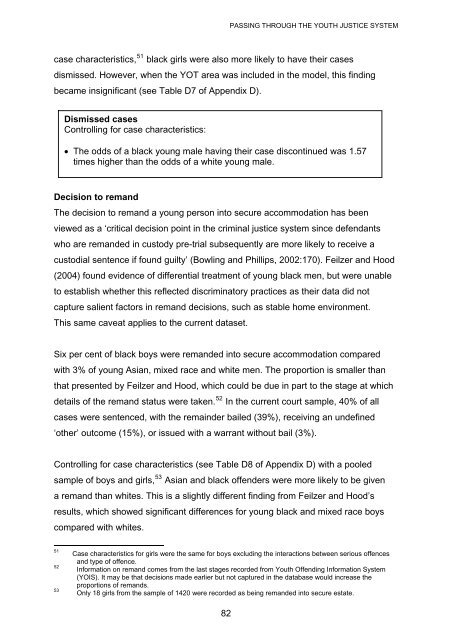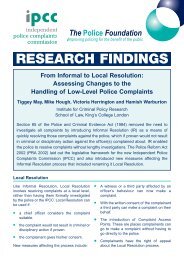Differential treatment in the youth justice system - Equality and ...
Differential treatment in the youth justice system - Equality and ...
Differential treatment in the youth justice system - Equality and ...
Create successful ePaper yourself
Turn your PDF publications into a flip-book with our unique Google optimized e-Paper software.
PASSING THROUGH THE YOUTH JUSTICE SYSTEMcase characteristics, 51 black girls were also more likely to have <strong>the</strong>ir casesdismissed. However, when <strong>the</strong> YOT area was <strong>in</strong>cluded <strong>in</strong> <strong>the</strong> model, this f<strong>in</strong>d<strong>in</strong>gbecame <strong>in</strong>significant (see Table D7 of Appendix D).Dismissed casesControll<strong>in</strong>g for case characteristics:• The odds of a black young male hav<strong>in</strong>g <strong>the</strong>ir case discont<strong>in</strong>ued was 1.57times higher than <strong>the</strong> odds of a white young male.Decision to rem<strong>and</strong>The decision to rem<strong>and</strong> a young person <strong>in</strong>to secure accommodation has beenviewed as a ‘critical decision po<strong>in</strong>t <strong>in</strong> <strong>the</strong> crim<strong>in</strong>al <strong>justice</strong> <strong>system</strong> s<strong>in</strong>ce defendantswho are rem<strong>and</strong>ed <strong>in</strong> custody pre-trial subsequently are more likely to receive acustodial sentence if found guilty’ (Bowl<strong>in</strong>g <strong>and</strong> Phillips, 2002:170). Feilzer <strong>and</strong> Hood(2004) found evidence of differential <strong>treatment</strong> of young black men, but were unableto establish whe<strong>the</strong>r this reflected discrim<strong>in</strong>atory practices as <strong>the</strong>ir data did notcapture salient factors <strong>in</strong> rem<strong>and</strong> decisions, such as stable home environment.This same caveat applies to <strong>the</strong> current dataset.Six per cent of black boys were rem<strong>and</strong>ed <strong>in</strong>to secure accommodation comparedwith 3% of young Asian, mixed race <strong>and</strong> white men. The proportion is smaller thanthat presented by Feilzer <strong>and</strong> Hood, which could be due <strong>in</strong> part to <strong>the</strong> stage at whichdetails of <strong>the</strong> rem<strong>and</strong> status were taken. 52 In <strong>the</strong> current court sample, 40% of allcases were sentenced, with <strong>the</strong> rema<strong>in</strong>der bailed (39%), receiv<strong>in</strong>g an undef<strong>in</strong>ed‘o<strong>the</strong>r’ outcome (15%), or issued with a warrant without bail (3%).Controll<strong>in</strong>g for case characteristics (see Table D8 of Appendix D) with a pooledsample of boys <strong>and</strong> girls, 53 Asian <strong>and</strong> black offenders were more likely to be givena rem<strong>and</strong> than whites. This is a slightly different f<strong>in</strong>d<strong>in</strong>g from Feilzer <strong>and</strong> Hood’sresults, which showed significant differences for young black <strong>and</strong> mixed race boyscompared with whites.515253Case characteristics for girls were <strong>the</strong> same for boys exclud<strong>in</strong>g <strong>the</strong> <strong>in</strong>teractions between serious offences<strong>and</strong> type of offence.Information on rem<strong>and</strong> comes from <strong>the</strong> last stages recorded from Youth Offend<strong>in</strong>g Information System(YOIS). It may be that decisions made earlier but not captured <strong>in</strong> <strong>the</strong> database would <strong>in</strong>crease <strong>the</strong>proportions of rem<strong>and</strong>s.Only 18 girls from <strong>the</strong> sample of 1420 were recorded as be<strong>in</strong>g rem<strong>and</strong>ed <strong>in</strong>to secure estate.82






